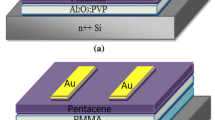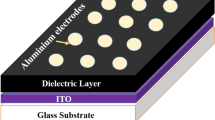Abstract
We report, the influence of Al2O3 nanoparticles (NP) incorporation on the dielectric properties of solution processed polyvinylalcohol (PVA) films for organic field effect transistor applications. It was observed typical p-type organic field effect transistors. Devices processed using employing PVA films blended with 70 wt% of Al2O3 NP as gate dielectric layers demonstrated higher field effect mobility, better saturation behavior and reduced hysteresis phenomenon compared to the devices based on pure PVA films. Al2O3 NP:PVA blends based dielectric films with 0, 3, 5, 10, 20, 50 and 70 wt% concentrations of Al2O3 NP compared to the weight of PVA were prepared. Dielectric parameters such as dielectric constant and dielectric strength of the Al2O3 NP:PVA films were analyzed. It was found that real dielectric constant as well as dielectric strength of the films increase with increase of Al2O3 NP concentration. Cole–Cole plots of the films demonstrated depressed semi-circles which points non-Debye type behavior. We presume that the devices being investigated with promising results, may be utilized for some industrial applications such as large area sensor arrays in future.







Similar content being viewed by others
References
M. Muccini, A bright future for organic field-effect transistors. Nat. Mater. 5(8), 605 (2006)
Y.M. Park et al., Solution-processable zirconium oxide gate dielectrics for flexible organic field effect transistors operated at low voltages. Chem. Mater. 25(13), 2571–2579 (2013)
H. Ye et al., SiC nanowires synthesized from electrospun nanofiber templates. Adv. Mater. 17(12), 1531–1535 (2005)
M.-S. Lu et al., Low voltage operation of non-volatile flexible OFET memory devices using high-k P (VDF-TrFE) gate dielectric and polyimide charge storage layer. React. Funct. Polym. 108, 39–46 (2016)
Z. Liu et al., Binary polymer composite dielectrics for flexible low-voltage organic field-effect transistors. Org. Electron. 53, 205–212 (2018)
Y. Zhou, S.-T. Han, V. Roy, Nanocomposite dielectric materials for organic flexible electronics. Nanocryst. Mater. (2014). https://doi.org/10.1016/B978-0-12-407796-6.00006-3
X. Xu et al., Organic and hybrid organic-inorganic flexible optoelectronics: recent advances and perspectives. Synth. Met. 256, 116137 (2019)
Q. Li et al., Solution-processed ferroelectric terpolymer nanocomposites with high breakdown strength and energy density utilizing boron nitride nanosheets. Energy Environ. Sci. 8(3), 922–931 (2015)
A.-L. Deman, J. Tardy, PMMA–Ta2O5 bilayer gate dielectric for low operating voltage organic FETs. Org. Electron. 6(2), 78–84 (2005)
A. Bahari, M. Shahbazi, Electrical properties of PVP–SiO 2–TMSPM hybrid thin films as OFET gate dielectric. J. Electron. Mater. 45(2), 1201–1209 (2016)
S. Khound, R. Sarma, Low-voltage organic thin film transistors (OTFTs) using crosslinked polyvinyl alcohol (PVA)/neodymium oxide (Nd2 O3) bilayer gate dielectrics. Appl. Phys. A 124(1), 41 (2018)
M.J. Tadjer et al., Editors’ choice communication—A (001) β-Ga2O3 MOSFET with +2.9 V threshold voltage and HfO2 gate dielectric. ECS J. Solid State Sci. Technol. 5(9), P468–P470 (2016)
Gao, Z., et al. Thermal stability study of AlGaN/GaN MOS-HEMTs using Gd2 O3 as gate dielectric. in electron devices (CDE), 2015 10th Spanish Conference on. (2015). IEEE
S. Huang et al., O3-sourced atomic layer deposition of high quality Al2O3 gate dielectric for normally-off GaN metal-insulator-semiconductor high-electron-mobility transistors. Appl. Phys. Lett. 106(3), 033507 (2015)
K. Yu et al., Fabrication of high-hole-mobility germanium-on-insulator wafers through an easy method. J. Alloy. Compd. 750, 182–188 (2018)
X. Huang, P. Jiang, Core–shell structured high-k polymer nanocomposites for energy storage and dielectric applications. Adv. Mater. 27(3), 546–554 (2015)
Motha, K., et al., Polymer composition comprising a blend of a multimodal polyethylene and a further ethylene polymer suitable for the production of a drip irrigation pipe. (2018), Google Patents
M.S. de Luna, G. Filippone, Effects of nanoparticles on the morphology of immiscible polymer blends–challenges and opportunities. Eur. Polym. J. 79, 198–218 (2016)
T.M. Brenner et al., Hybrid organic—inorganic perovskites: low-cost semiconductors with intriguing charge-transport properties. Nat. Rev. Mater. 1(1), 15007 (2016)
L. Mohammed et al., A review on natural fiber reinforced polymer composite and its applications. Int. J. Polym. Sci. (2015). https://doi.org/10.1155/2015/243947
Y.S. Rim et al., Recent progress in materials and devices toward printable and flexible sensors. Adv. Mater. 28(22), 4415–4440 (2016)
N.Z. Karimi, G. Minak, P. Kianfar, Analysis of damage mechanisms in drilling of composite materials by acoustic emission. Compos. Struct. 131, 107–114 (2015)
Y. Rao, C. Wong, Material characterization of a high-dielectric-constant polymer–ceramic composite for embedded capacitor for RF applications. J. Appl. Polym. Sci. 92(4), 2228–2231 (2004)
J.M. Whiteley et al., Ultra-thin solid-state Li-ion electrolyte membrane facilitated by a self-healing polymer matrix. Adv. Mater. 27(43), 6922–6927 (2015)
M.R. Beaulieu et al., Solution processable high dielectric constant nanocomposites based on ZrO2 nanoparticles for flexible organic transistors. ACS Appl. Mater. Interfaces. 5(24), 13096–13103 (2013)
B. Luo et al., Fabrication, characterization, properties and theoretical analysis of ceramic/PVDF composite flexible films with high dielectric constant and low dielectric loss. J. Mater. Chem. A 2(2), 510–519 (2014)
B. Luo et al., Synthesis, characterization and dielectric properties of surface functionalized ferroelectric ceramic/epoxy resin composites with high dielectric permittivity. Compos. Sci. Technol. 112, 1–7 (2015)
B. Hussien, The DC and AC electrical properties of (PMMA-Al2O3) composites. Eur. J. Sci. Res. 52, 236–242 (2011)
S. Han et al., Performance improvement of organic field-effect transistor ammonia gas sensor using ZnO/PMMA hybrid as dielectric layer. Sens. Actuators, B 203, 9–16 (2014)
J. Li et al., Solution-processable organic and hybrid gate dielectrics for printed electronics. Mater. Sci. Eng., R 127, 1–36 (2018)
S. Mallakpour, M. Dinari, Enhancement in thermal properties of poly (vinyl alcohol) nanocomposites reinforced with Al2O3 nanoparticles. J. Reinf. Plast. Compos. 32(4), 217–224 (2013)
S.-C. Chang, Y.-J. Hsiao, T.-S. Li, Selecting annealing temperature of P3HT/PCBM incorporated with nano-diamonds using thermal desorption spectroscopy. Int. J. Electrochem. Sci. 10, 1658–1668 (2015)
P. Ortiz-Serna et al., Dielectric spectroscopy of natural rubber-cellulose II nanocomposites. J. Non-Cryst. Solids 357(2), 598–604 (2011)
A.S. Roy et al., Dielectric properties of novel PVA/ZnO hybrid nanocomposite films. Compos. B 47, 314–319 (2013)
R. Hill, L. Dissado, Debye and non-debye relaxation. J. Phys. C 18(19), 3829 (1985)
C. Rost-Bietsch, Ambipolar and light-emitting organic field-effect transistors (Cuvillier Verlag, Gottingen, 2005)
Author information
Authors and Affiliations
Corresponding author
Additional information
Publisher's Note
Springer Nature remains neutral with regard to jurisdictional claims in published maps and institutional affiliations.
Rights and permissions
About this article
Cite this article
Canimkurbey, B., Çakirlar, Ç., Piravadili Mucur, S. et al. Influence of Al2O3 nanoparticles incorporation on the dielectric properties of solution processed PVA films for organic field effect transistor applications. J Mater Sci: Mater Electron 30, 18384–18390 (2019). https://doi.org/10.1007/s10854-019-02192-1
Received:
Accepted:
Published:
Issue Date:
DOI: https://doi.org/10.1007/s10854-019-02192-1




